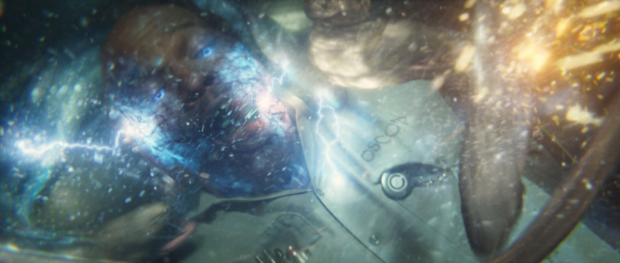MPC Vancouver teams up with director Marc Webb and Sony Pictures Imageworks VFX Supervisor Jerome Chen to complete more than 300 shots for ‘The Amazing Spider-Man 2.’
MPC Vancouver teamed up with director Marc Webb and Sony Pictures Imageworks VFX Supervisor Jerome Chen to complete more than 300 shots for The Amazing Spider-Man 2.
Led by MPC’s VFX Supervisor Erik Nordby and Producer Doug Oddy, the team’s main areas of work included three electrifying sequences: Max Dillon falling into a tank of mutant electric eels and beginning his transformation into Electro; Harry Osborn's vein bulging transformation into the Green Goblin; and an explosive aircraft collision. MPC was also responsible for building several New York City environments and various Oscorp building environments and set extensions.
The first sequence undertaken by the MPC team was the Oscorp building elevator sequence, in which Spider-Man’s true love, Gwen Stacy, first meets Max Dillon, the Oscorp engineer who is later transformed into Electro. The scene was shot in a glass elevator, set against a green screen, with the outside environment and background activity created by MPC’s team. They created 90 unique floors at 6k resolution, including offices, labs, and lobbies utilizing MPC’s in-house crowd software to create the employees walking around the building.
A key turning point in the movie is Max’s transformation into Electro after he falls into a tank of electric eels. For this scene, MPC used footage of a stuntman falling into the tank for the impact, and close-up references of Jamie Foxx’s face, and then roto animated a digital double of Foxx in the tank. CG electric eels were created and blended with electricity effects, bubbles and froth.
The team created 30 different eels from reference footage collected at the Vancouver Aquarium, adding extra facial and personality features to make them appear more aggressive and enforce the feeling that they are not typical eels. The animation team animated the creatures biting and wrapping around Max, transferring their energy into him.
The build-up of electricity shatters the glass of the tank, which was filmed on set, and MPC added CG water effects to enhance the sequence, as well as adding the eels that pour out of the tank with Max. For the last few shots of the scene, Max is a full CG model.
For Harry Osborn’s transformation into the Green Goblin, the actor’s body was roto animated and pulsing veins were added, along with animated growing nail and teeth.
MPC also created the sequence in which a Boeing 747 and an Airbus collide after Electro drains the power supply, leaving the city in darkness. This included developing special day-for-night techniques to light the planes and surrounding city shots. The environment team spent over two months creating a highly detailed matte painting of New York, referencing real photos of the city at different times of the day, and then projecting the city’s buildings onto geometry.
The Amazing Spider-Man 2 is now playing in theatres worldwide.
We’ve always known that Spider-Man’s most important conflict has been within himself: the struggle between the ordinary obligations of Peter Parker and the extraordinary responsibilities of Spider-Man. But in The Amazing Spider-Man 2, Peter Parker finds that his greatest battle is about to begin.
It’s great to be Spider-Man (Andrew Garfield). For Peter Parker, there’s no feeling quite like swinging between skyscrapers, embracing being the hero, and spending time with Gwen (Emma Stone). But being Spider-Man comes at a price: only Spider-Man can protect his fellow New Yorkers from the formidable villains that threaten the city. With the emergence of Electro (Jamie Foxx), Peter must confront a foe far more powerful than he. And as his old friend, Harry Osborn (Dane DeHaan), returns, Peter comes to realize that all of his enemies have one thing in common: Oscorp. Directed by Marc Webb. Produced by Avi Arad and Matt Tolmach. Screenplay by Alex Kurtzman & Roberto Orci & Jeff Pinkner. Screen Story by Alex Kurtzman & Roberto Orci & Jeff Pinkner and James Vanderbilt. Based on the Marvel Comic Book by Stan Lee and Steve Ditko. The Executive Producers are E. Bennett Walsh, Stan Lee, Alex Kurtzman, and Roberto Orci.
Source: MPC















